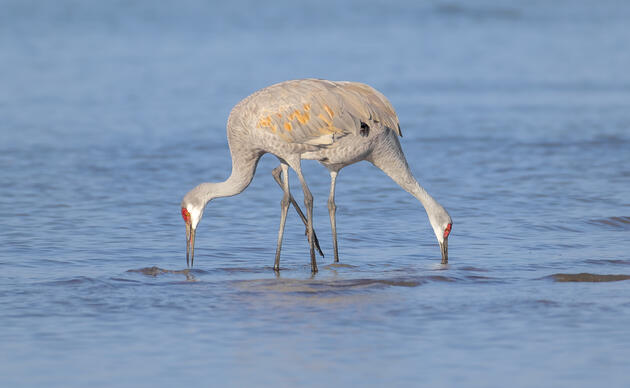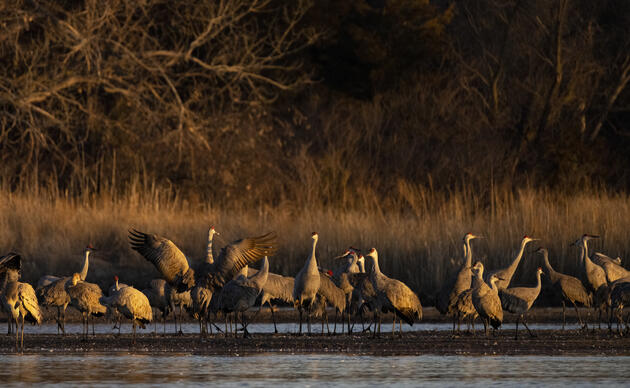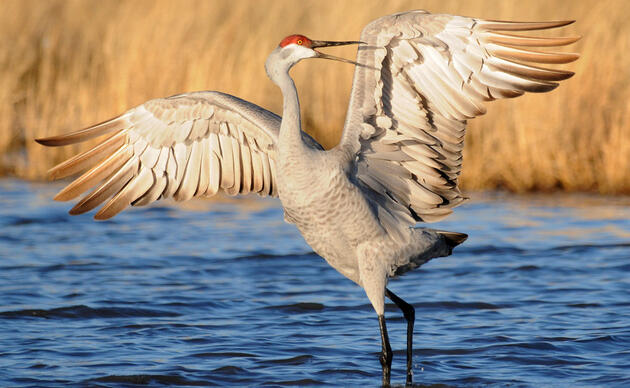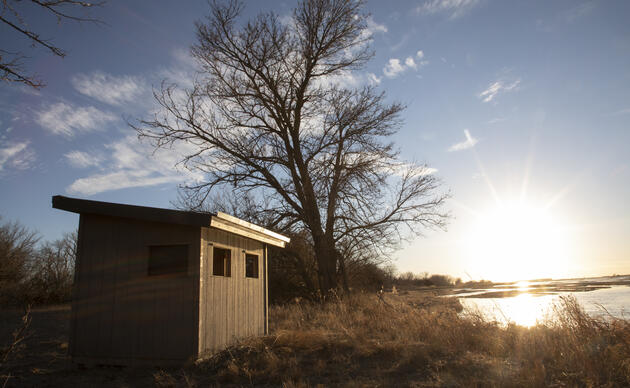Should We Come to See the Cranes?
First things first. Should you come see the sandhill cranes on the Platte River, Nebraska, sometime in late March or early April?
The answer is an emphatic yes. The cranes are beautiful, inspiring, and uplifting. My partner, Susan, and I equivocated for a few months before we finally decided, yes, we want to travel from New Hampshire to Kearney, Nebraska, to see an annual migration that we didn’t know much about. When we mentioned our plans to friends and family, most of them had never heard of the sandhill cranes. Some of them asked, understandably, why two people would leave late winter New England to travel to late winter Nebraska. Did somebody close down all the warmer vacation spots? It puzzled them. Their puzzlement made us doubt, at times, the advisability of our plan.
But we went anyway. And we loved it.
You will too. Unless…
This is hard to say without being slightly insensitive. But here goes: if you don’t get stirred up by sunrises, or first snow storms, or the sound of geese overhead, or autumn leaves, or salmon jumping up a river waterfall – then this might not be the thing for you. If you prefer your sports indoors, need lights and activity to have a good time, then the cranes may be the wrong choice. This is not Las Vegas. This is the type of experience that appeals to your quieter side, if it appeals at all. It takes time. You need patience.
All that said, I wouldn’t have missed the migration for anything.
When Should We Come?
You can relax around this question. You can’t miss the cranes. That’s the important part. As long as you arrive around the beginning of March to, maybe, the middle of April, you will see cranes. Lots of cranes. Personally, my guess is that March will allow you to see greater flocks, but I could be wrong about that. You can always contact the Rowe Sanctuary, one of two great resources for all things crane. (The other is the Crane Trust, also wonderful.) In fact, you can watch the camera feeds from each organization and get a feeling for what you will experience on site.
A little anecdote: When my partner and I arrived, I was worried that we had come all this way and perhaps we wouldn’t see many cranes. We flew into Lincoln and drove two hours on I-80 west. At one point Susan looked up in the sky and asked, “Are those cranes?”
I looked up through the windshield and realized, yes, those were cranes. We rolled down the windows and heard them. About an hour later – after stopping at the Crane Trust – we pulled next to a corn field in its winter dormancy. I looked out and thought I was spotting a bunch of tires set out to hold down a tarp. My girlfriend, a true New Englander, figured she was looking at a stone wall. Inch by inch, we realized we were observing a quarter mile, at least, of birds. Big birds. Pewter colored.
They were everywhere. Simply everywhere.
Unless you make the trip at a wildly unfortunate time, you will see more cranes, and probably more living creatures all at once, than you have ever seen in your life.
What Should We Bring?
Binoculars! If possible, each individual should have a pair. You’re going to want to see birds. My binoculars were adequate; Susan’s binoculars were equipped with a zoom feature that worked to bring the birds up close. Unless I’m mistaken, you can’t rent any binoculars at either of the crane institutions. Borrow or beg a pair from friends or family members. Bring the best you can snag.
Also, bring warm clothes. Plenty of them. We were lucky and hit a good patch of weather, but the Nebraska plains can be fearsome at times. We did not directly experience that kind of sharp wind, but in the place we stayed – an AirBnB in Kearney – the visitors’ log described harsh winter weather that made observing the birds almost painful. You have to dress for the weather.
One thing that might be helpful when packing: We didn’t really need heavy boots. Warm shoes? Yes. A decent tread? Yes. We had thought of bringing knee high muck boots but decided at the last minute to leave them home. It was a good decision. Unless your plans include mushing through a marsh or two – and there are places and birds to see that way – most of what you will walk on will be good paths, dirt or cement, and, because it’s Nebraska, almost always level. Of course, snow is possible, but I suspect a decent hiking boot will serve as well as anything. And for the most part, you will usually be near your car and the heat that the vehicle provides.
Where Should We Stay?
Obviously, where you stay is up to you. We stayed in Kearney and wanted to move there by the end of our visit. We booked a great AirBnB, went out Saturday night to a $5 movie, ate good tavern type meals at Cunningham’s Journal, had coffee at a café on Main Street, and thoroughly enjoyed the feeling in the town that spoke to civic revival. Small town America at its best, really.
The ride from downtown Kearney out to the Rowe Sanctuary took about 15 minutes of easy driving. Again, everything is flat and set out mostly on a grid. Being close enough for easy viewing makes it possible to go see the birds for a while, then come home for a nap or a meal, and then run back out at sunset.
A point about that: You want to be on the Platte River at sunrise and sunset. Not only did Nebraska show us beautiful skies with red slices of waning or waxing light, but the birds are most dramatic in those moments. In the morning, the birds wait impatiently for the sun to rise, then they kettle – fly up – in the great masses you made the trip to see. Reverse it at sunset. The birds fly in from every direction and make a cacophony of calls and noise as they land and settle in for the night.
For my money, a twenty minute drive back to Kearney at that point is hard to beat. Some people we met drove in from Lincoln, or other various locations, but we were always grateful for the short trip back to our rental.
The last point about location is one’s proximity to the Rowe Sanctuary. If the migration of the sandhill cranes is a hurricane, Rowe Sanctuary is the eye. Some of our best moments of viewing came in the middle of the day in the blinds maintained by the Rowe Sanctuary staff. The “blinds” are wooden buildings – think of baseball dugouts on a good little league field – that afford a dramatic view of the birds in the water. I’ll say more about the blinds in a moment, but they are absolutely worth a visit. Cranes are observable from the blinds in perhaps the most up-close manner possible. They are also staffed by wonderful, informative, guides/volunteers, who can point out things you might have missed. When Susan and I visited one of the blinds, a guide alerted us to a trio of Bald Eagles sitting on a mud bank, watching – we conjectured – for an opportunity. We would have missed it without the guide and the nearness of the blind.
While We Are On the Topic, A Word About the Blinds:
Yes, book a spot in the blinds if possible. That was our one regret. By the time we had decided definitely to visit Nebraska, the blinds were already booked to capacity. As I mentioned, the blinds give you access to the best views of the birds, especially for the morning and evening congregations. Staying in a blind, you will witness thousands of birds zooming in and making camp for the night, or springing into the air – in numbers hard to believe – at first light. Not booking a blind was a little like going to Venice and skipping the gondolas. The blinds, and the close action, really sets the experience apart.
That said, however, as I’ve already mentioned, you can see plenty of birds no matter what. We watched from a wooden viewing platform south of the Rowe Sanctuary and saw birds land within, maybe, one hundred yards from us. Lots of birds. We also saw them take off in the morning. A little viewing party of maybe thirty people surrounded us. It was a good group, happy in its demeanor and respectful of the cranes.
A Little Helpful Information
The cranes congregate mostly south of the Platte River, solidly in farm country. They are eating last season’s dropped corn. That means you see them, by and large, on land during the day, and in the water at sunrise and sunset. The water serves as a protection against predators. The cranes are warned by splashes if anything approaches.
The farm country is lined by rural roads. Some are paved, but many are dirt. But they are all in good shape and easily navigable unless the weather becomes fierce. You’ll see people driving around, pulling over, then spending time watching the cranes while using their car as a blind. Some take photos, but many simply watch. The atmosphere is typically affable and cooperative.
In the most general sense, the Crane Trust is on the eastern edge of the crane landscape, and the Rowe Sanctuary is on the west. It is not at all intimidating or confusing once you get the general idea. Here is the 2022 Crane Watch map:
https://simplebooklet.com/cranewatchguidekearneynebraska
Notice that the roads south of the river follow the I-80 line. You can’t get lost.
A word, too, about both the Crane Trust and Rowe Sanctuary staffers. To a person, they were remarkably kind and helpful. They clearly love the cranes and want to do whatever they can to help the birds on their migration. Don’t be shy. Stop in and talk to them. Sign up for an hour long talk to hear about crane behavior. It will be interesting, and the fee goes toward crane conservation.
How Long Should We Stay?
Obviously, this is a subjective opinion, but the truth is you can probably see enough of the cranes in two to three days. Barring the desire to photograph them in special ways, or to study their biology, seeing the birds for a day or two or three will satisfy most people. Remember, you will probably want to go to the river at least twice a day – at sunrise and sunset – so three days becomes six viewing opportunities, and that will likely be sufficient.
Rowe Sanctuary offers special photography sessions, and overnight camp outs in the blinds, but that’s a personal choice. You can find out all about those opportunities on the Rowe Sanctuary website.
Your Attitude Will Make the Trip
Have fun. Enjoy it. It’s all extremely manageable. If the cranes can’t put you in a good mindset, then I don’t know what will. This is a beautiful moment you get to share with perhaps the greatest migrations on our continental United States. Embrace it. Put down the binoculars from time to time and simply take it all in.
Susan and I say often that we miss the cranes. And we do. They stirred us and affirmed the beauty of life. See them if you can. They won’t disappoint you.




